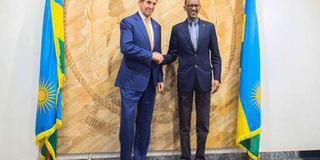Diplomats agree on phase-out of greenhouse gases

President Paul Kagame (right) and the US Secretary of State John Kerry shake hands after their bilateral meeting at the President office known as Urugwiro Village in Kigali on October 14, 2016 during the 28th Meeting of the Parties to the Montreal Protocol. Envoys from nearly 200 nations are in the Rwandan capital to thrash out an agreement to phase out hydrofluorocarbons. PHOTO | AFP
What you need to know:
- Under the amendment to the 1987 Montreal Protocol on protecting the ozone layer, rich countries are to take action sooner than developing nations.
- The Paris agreement aimed to keep global warming below two degrees Celsius, compared with pre-industrial levels.
KIGALI
In a major step toward curbing global warming, world envoys have reached an agreement to phase out potent greenhouse gases used in refrigerators and air conditioners.
Under the amendment to the 1987 Montreal Protocol on protecting the ozone layer, rich countries are to take action sooner than developing nations.
The agreement was greeted by applause from exhausted envoys who had worked through the night in the Rwandan capital to put the final touches on the deal to phase out production and consumption of hydrofluorocarbons.
“Last year in Paris, we promised to keep the world safe from the worst effects of climate change. Today, we are following through on that promise,” said UN Environment Programme chief Erik Solheim.
The US Environmental Protection Agency said: “This day will unquestionably be remembered as one of the most important in our effort to save the planet.”
But some representatives voiced regret that countries such as India and Gulf nations would begin the transition later than others.
“It may not be entirely what the islands wanted, but it is a good agreement,” said a representative of the tiny Pacific nation of Marshall Islands, Mattlan Zackhras.
“We all know we must go further, and we will.”
“It was a shame that India and a handful of other countries chose a slower timeframe for phasing down HFCs,” Christian Aid’s senior policy adviser, Benson Ireri, said in a statement.
But he added that the international community had passed its first real test since the Paris climate deal last year.
GLOBAL WARMING
The Paris agreement aimed to keep global warming below two degrees Celsius, compared with pre-industrial levels.
The elimination of HFCs could reduce global warming by 0.5 degrees by 2100, according to a 2015 study by the Institute for Governance and Sustainable Development.
Attended by representatives of nearly 200 countries, including US Secretary of State John Kerry, the talks involved tough negotiations, with major developing nations like India putting up a fight over the timeline for phasing out HFCs and financing the transition.
HFCs were introduced in the 1990s to replace chemicals that had been found to erode the ozone layer, but turned out to be catastrophic for global warming.
However, swapping HFCs for alternatives such as ammonia, water or gases called hydrofluoroolefins could prove costly for developing countries with sweltering summer temperatures, like India.
“There are issues of cost, there are issues of technology, there are issues of finances,” said Ajay Narayan Jha of India’s environment and climate change ministry before the deal was announced.
“We would like to emphasise that any agreement will have to be flexible from all sides concerned. It can’t be flexible from one side.”
HFCs’ predecessors, chlorofluorocarbons, were discontinued under the Montreal Protocol when it was realised they were destroying the ozone layer. This blanket of gas in the stratosphere protects Earth from the Sun’s ultraviolet rays.
But it emerged that HFCs, while safe for the now-healing ozone, are thousands of times worse for trapping heat than carbon dioxide, the main greenhouse gas.
According to studies, air conditioning is the cause of the largest growth in HFCs — and the world is likely to have another 700 million air conditioners by 2030.




